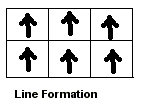Sequence of Play:
1. Treachery Die Roll
2. Eastern Army Moves
3. Eastern Army Shoots
4. Western Army Moves
5. Western Army Shoots
6. Charges
7. Melee
Treachery Die Roll:
Kobayakawa Hideaki was part of the Western Army and had assured Mitsunari that he would do his part in the battle. However he was conflicted about which side he really wanted to support and had also told Ieyasu that he would fight on his side. At the start of each turn one player rolls a die to see if Hideaki has decided to join the fight on behalf of either side. If he does join one side then he is treated as a part of that army for the remainder of the game, and no further die rolls are necessary. On turn one skip the treachery roll, he won't choose either side. On turn two he will join the East on a roll of 6, otherwise he remains undecided. On turn three he joins the East on a 5-6, and joins the West on a roll of 1. On turn four and all succeeding turns he joins the East on a 4-6, and the West on a 1-2.
| Treachery Die Roll | ||
|---|---|---|
| Turn | Joins East | Joins West |
| 1 | - | - |
| 2 | - | 6 |
| 3 | 1 | 5-6 |
| 4 | 1-2 | 4-6 |
 Movement:
Movement:
Cavalry and Infantry may move up to 6". Commanders may move up to 12"
Shooting:
Arquebusiers and Archer units can shoot 12". If any base in a unit is in range then all the bases in the unit may fire. Roll 1D6 per base, Each 6 rolled is a hit. The unit targeted removes one stand for each hit. Once a unit has fought a round of melee they may not shoot, or be shot at, until the melee is finished.
Charge into Melee: Both sides may charge into melee. This is the only way to get into hand-to-hand fighting. Units may charge up to 6" but only if they can reach an enemy unit. Charges must be made against enemies in front of the charging unit. If it makes a difference, the Eastern army charges first.
Melee:
Each side rolls 1D6 for each base in the fight. The Melee table shows the number needed to score hits. Remove one enemy stand for every hit. Both sides roll simultaneously. If both units still have stands left they remain engaged and fight again next turn.
| Melee | |
|---|---|
| Unit | To Hit |
| Cavalry, Leaders | 4-6 |
| Foot Samurai | 5-6 |
| Ashigaru Spears | 6 |
| Any vs. Archers of Arquebusiers | 4-6 |
Flank Attacks:
If a unit charges an enemy unit on the flank or rear it gains an advantage. The enemy unit may only fight back with two bases. Ths advantage applies only on the first turn of melee.
Remove the Last Stand: If a unit is reduced to one stand this last stand is removed immediately.
Leaders:
Leaders may not be targeted individually. If they are attached to a unit they count as an extra base in melee (but not shooting). If the unit they are attached to loses one or more bases in melee roll 1D6. If the roll is a 6 then the leader is eliminated.
Personal Combat:
If both sides have a leader involved in a melee they may chose to fight each other in personal combat. Both players must agree. Each side rolls one die to resolve the duel, high roll wins. Reroll ties. The loser is eliminated.
The Reluctant Samurai Battle of Sekigahara (1600)
Back to Table of Contents -- Junior General Report # 5
Back to Junior General Report List of Issues
Back to MagWeb.com Magazine List
© Copyright 2004 by Matt Fritz.
This article appears in MagWeb.com (Magazine Web) on the Internet World Wide Web. Other articles covering military history and related topics are available at http://www.magweb.com